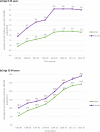Changing epidemiology and age-specific incidence of cutaneous malignant melanoma in England: An analysis of the national cancer registration data by age, gender and anatomical site, 1981-2018
- PMID: 34557790
- PMCID: PMC8454583
- DOI: 10.1016/j.lanepe.2021.100024
Changing epidemiology and age-specific incidence of cutaneous malignant melanoma in England: An analysis of the national cancer registration data by age, gender and anatomical site, 1981-2018
Abstract
Background: The incidence of cutaneous malignant melanoma, which is mostly attributable (86%) to UV radiation exposure, has been steadily increasing over the past four decades in predominantly fair-skinned populations. Although public health campaigns are increasing sun-protective behaviour in England, their effect on melanoma incidence is largely unknown. We conducted a retrospective population-based cohort study to examine whether there have been changes in the epidemiology of melanoma in England during the past four decades.
Methods: Individual level data for patients diagnosed with melanoma in England during 1981-2018 were obtained from the Office for National Statistics/Public Health England. Average annual incidence rates were calculated by three age categories (0-34, 35-64, 65+ years), gender and anatomical site during the seven five-year time periods (1981-85 to 2011-15) and the recent three-year period (2016-18). The percentage change in incidence was calculated as change in the average incidence rate from the first (1981-85) to the last time period (2016-18). The Average Annual Percentage Change (AAPC) was estimated using the slope of the linear trend line fitted to the incidence rates by year of diagnosis.
Findings: During the 38-year period (1981-2018), a total of 265,302 cases of melanoma (45.7% males, 54.3% females) were registered in England. The average annual number of cases increased from 837/year in 1981-85 to 6963/year in 2016-18 in males (+732%), and from 1609/year in 1981-85 to 6952/year in 2016-18 in females (+332%). In the young age-group (0-34 years), the average annual incidence rates initially increased from 1981-85 to 2001-05 and then stabilised during the recent period (2006-18). In the middle age group (35-64 years), the rates increased by +332% (AAPC, 10.4%) in males (from 5.6/100,000 in 1981-85 to 24.2/100,000 in 2016-18) and +185% (AAPC, 5.7%) in females (from 10.2/100,000 in 1981-85 to 29.1/100,000 in 2016-18); and in the old age-group (65+ years) the rates increased by +842% (AAPC, 25.7%) in males (from 9.6/100,000 in 1981-85 to 90.4/100,000 in 2016-18) and +381% (AAPC, 11.2%) in females (from 12.5/100,000 in 1981-85 to 60.1/100,000 in 2016-18). The largest increase in incidence in both males and females was observed for melanoma of the trunk (+817%, AAPC, 24.8% in males and +613%, AAPC, 18.3% in females), followed by melanoma of upper limb (+750%, AAPC, 22.9% in males and 518%, AAPC, 15.5% in females).
Interpretation: It appears that the incidence of melanoma among young people in England has stabilised (or levelled off) in recent decades, whereas it continues to increase substantially in older population. These findings suggest that public health campaigns targeted at children/adolescents/parents may be favourably influencing melanoma incidence. The steeper increase in incidence in males is consistent with their relatively greater sun exposure and poor sun-protective behaviour. All the available evidence suggests that the enormous increase in the melanoma of the trunk and upper limb, since the 1980s, is most likely due to increasing trend in intermittent high intensity recreational UV radiation exposure (e.g. sunbathing, holidaying in places with strong sunlight, indoor tanning).
Funding: This work was supported by Brighton and Sussex Medical School (BSMS).
Keywords: Cutaneous melanoma; England; Incidence; Malignant melanoma; Skin cancer.
© 2021 The Author(s).
Conflict of interest statement
The authors declare no conflict of interest.
Figures






References
-
- Bray F, Colombet M, Mery L, Piñeros M, Znaor A, Zanetti R, Ferlay J, editors. Cancer incidence in five continents, Vol. XI. International Agency for Research on Cancer; Lyon: 2017. https://ci5.iarc.fr Available from: accessed (Accessed 28 August 2020)
-
- Ferlay J, Colombet M, Soerjomataram I. International Agency for Research on Cancer/World Health Organization; Lyon: 2018. Global and regional estimates of the incidence and mortality for 38 cancers: GLOBOCAN 2018.https://gco.iarc.fr (Accessed 28 August 2020)
-
- Cancer Research UK: Cancer Statistics for the UK (www.cancerresearchuk.org/health-professional/cancer-statistics-for-the-uk (Accessed 28 August 2020).
-
- Whiteman D, Green A. In: Skin cancer – a world-wide perspective. Dummer R., editor. Springer-Verlag; Berlin Heidelberg: 2011. Epidemiology of malignant melanoma. - DOI
LinkOut - more resources
Full Text Sources
Miscellaneous

